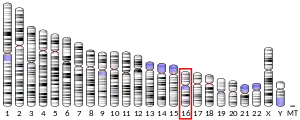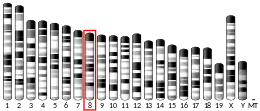Carbonic anhydrase 7
Carbonic anhydrase 7 (CA7) is an enzyme that in humans is encoded by the CA7 gene.[5][6]
Function
Carbonic anhydrases are a large family of zinc metalloenzymes that catalyze the reversible hydration of carbon dioxide. They participate in a variety of biological processes, including respiration, calcification, acid-base balance, bone resorption, and the formation of aqueous humor, cerebrospinal fluid, saliva, and gastric acid. They show extensive diversity in tissue distribution and in their subcellular localization. The cytosolic protein encoded by this gene is predominantly expressed in the salivary glands. Alternative splicing in the coding region results in multiple transcript variants encoding different isoforms.[6]
References
- GRCh38: Ensembl release 89: ENSG00000168748 - Ensembl, May 2017
- GRCm38: Ensembl release 89: ENSMUSG00000031883 - Ensembl, May 2017
- "Human PubMed Reference:". National Center for Biotechnology Information, U.S. National Library of Medicine.
- "Mouse PubMed Reference:". National Center for Biotechnology Information, U.S. National Library of Medicine.
- Montgomery JC, Venta PJ, Eddy RL, Fukushima YS, Shows TB, Tashian RE (Dec 1991). "Characterization of the human gene for a newly discovered carbonic anhydrase, CA VII, and its localization to chromosome 16" (PDF). Genomics. 11 (4): 835–48. doi:10.1016/0888-7543(91)90006-Z. hdl:2027.42/29017. PMID 1783392.
- "Entrez Gene: CA7 carbonic anhydrase VII".
Further reading
- Sly WS, Hu PY (1995). "Human carbonic anhydrases and carbonic anhydrase deficiencies". Annual Review of Biochemistry. 64: 375–401. doi:10.1146/annurev.bi.64.070195.002111. PMID 7574487.
- Breton S (Jul 2001). "The cellular physiology of carbonic anhydrases". JOP. 2 (4 Suppl): 159–64. PMID 11875253.
- Rivera C, Voipio J, Kaila K (Jan 2005). "Two developmental switches in GABAergic signalling: the K+-Cl- cotransporter KCC2 and carbonic anhydrase CAVII". The Journal of Physiology. 562 (Pt 1): 27–36. doi:10.1113/jphysiol.2004.077495. PMC 1665491. PMID 15528236.
- Loftus BJ, Kim UJ, Sneddon VP, Kalush F, Brandon R, Fuhrmann J, Mason T, Crosby ML, Barnstead M, Cronin L, Deslattes Mays A, Cao Y, Xu RX, Kang HL, Mitchell S, Eichler EE, Harris PC, Venter JC, Adams MD (Sep 1999). "Genome duplications and other features in 12 Mb of DNA sequence from human chromosome 16p and 16q". Genomics. 60 (3): 295–308. doi:10.1006/geno.1999.5927. PMID 10493829.
- Chagnon P, Michaud J, Mitchell G, Mercier J, Marion JF, Drouin E, Rasquin-Weber A, Hudson TJ, Richter A (Dec 2002). "A missense mutation (R565W) in cirhin (FLJ14728) in North American Indian childhood cirrhosis". American Journal of Human Genetics. 71 (6): 1443–9. doi:10.1086/344580. PMC 378590. PMID 12417987.
- Vullo D, Voipio J, Innocenti A, Rivera C, Ranki H, Scozzafava A, Kaila K, Supuran CT (Feb 2005). "Carbonic anhydrase inhibitors. Inhibition of the human cytosolic isozyme VII with aromatic and heterocyclic sulfonamides". Bioorganic & Medicinal Chemistry Letters. 15 (4): 971–6. doi:10.1016/j.bmcl.2004.12.052. PMID 15686895.
External links
- PDBe-KB provides an overview of all the structure information available in the PDB for Human Carbonic anhydrase 7
This article is issued from Wikipedia. The text is licensed under Creative Commons - Attribution - Sharealike. Additional terms may apply for the media files.




